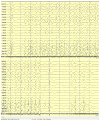The incidence of seizures in patients undergoing therapeutic hypothermia after resuscitation from cardiac arrest
- PMID: 23906560
- PMCID: PMC3961478
- DOI: 10.1016/j.eplepsyres.2013.06.018
The incidence of seizures in patients undergoing therapeutic hypothermia after resuscitation from cardiac arrest
Abstract
Study objective: Non-convulsive seizures/status epilepticus occur in approximately 20% of comatose, non-cardiac arrest intensive care unit (ICU) patients, and are associated with increased mortality. The prevalence and clinical significance of seizures in comatose survivors of cardiac arrest undergoing therapeutic hypothermia is not well described.
Methods: At this urban level I trauma center, every patient undergoing therapeutic hypothermia is monitored with continuous video encephalography (cvEEG). We abstracted medical records for all cardiac arrest patients treated with therapeutic hypothermia during 2010. Clinical data were extracted in duplicate. cvEEGs were independently reviewed for seizures by two board-certified epileptologists.
Results: There were 33 patients treated with therapeutic hypothermia after cardiac arrest in 2010 who met inclusion criteria for this study. Median age was 58 (range 28-86 years), 63% were white, 55% were male, and 9% had a history of seizures or epilepsy. During cooling, seizures occurred in 5/33 patients (15%, 95%CI 6%-33%). 11/33 patients (33%, 95% CI 19%-52%) had seizures at some time during hospitalization. 13/33 (39%) survived to discharge and of these, 7/13 (54%) survived to 30 days. 9/11 patients with seizures died during hospitalization, compared with 11/22 patients without seizures (82% vs. 50%; difference 32%, CI 951%-63%). No patient with seizures was alive at 30 days.
Conclusions: Seizures are common in comatose patients treated with therapeutic hypothermia after cardiac arrest. All patients with seizures were deceased within 30 days of discharge. Routine use of EEG monitoring could assist in early detection of seizures in this patient population, providing an opportunity for intervention to potentially improve outcomes.
Keywords: Cardiac arrest; Continuous EEG; Non-convulsive seizures; Seizures; Therapeutic hypothermia.
Copyright © 2013 Elsevier B.V. All rights reserved.
Conflict of interest statement
There are no conflicts of interest from any author as it pertains to this manuscript.
Figures
References
-
- Neumar RW, et al. Post-cardiac arrest syndrome: epidemiology, pathophysiology, treatment, and prognostication. A consensus statement from the International Liaison Committee on Resuscitation (American Heart Association, Australian and New Zealand Council on Resuscitation, European Resuscitation Council, Heart and Stroke Foundation of Canada, InterAmerican Heart Foundation, Resuscitation Council of Asia, and the Resuscitation Council of Southern Africa); the American Heart Association Emergency Cardiovascular Care Committee; the Council on Cardiovascular Surgery and Anesthesia; the Council on Cardiopulmonary, Perioperative, and Critical Care; the Council on Clinical Cardiology; and the Stroke Council. Circulation. 2008;118(December 23):2452–2483. - PubMed
-
- Towne AR, Waterhouse EJ, Boggs JG, et al. Prevalence of nonconvulsive status epilepticus in comatose patients. Neurology. 2000;54:340–345. - PubMed
-
- Claassen J, Mayer SA, Kowalski RG, Emerson RG, Hirsch LJ. Detection of electrographic seizures with continuous EEG monitoring in critically ill patients. Neurology. 2004;62:1743–1748. - PubMed
Publication types
MeSH terms
Grants and funding
LinkOut - more resources
Full Text Sources
Other Literature Sources
Medical
Miscellaneous



